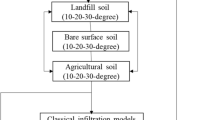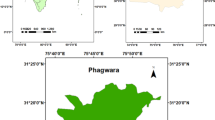Abstract
Infiltration process tends to be one of the most essential elements of the hydrological cycle. Comprehensive and thorough information on soil infiltration in both temporal and spatial territories can support maintaining environmental and hydrological development. Traditional methods to measure soil infiltration are costly, time-consuming, and their facility to regain the spatial and temporal inconsistency, particularly in large scale areas. In this context, remote sensing is capable of providing meaningful information for counting preliminary soil infiltration on various spatial scales via spectral reflectance variability. The present study aims at developing a mathematical model to determine the spatially distributed infiltration using artificial neural networks (ANN) combined with geographical information system (GIS), remote sensing (RS), and field infiltration measurements using a double ring infiltrometer in the Wadi Al-Ratga in the Iraqi western desert. The performance of the proposed model was assessed both qualitatively and quantitatively by comparing the results measured against estimated infiltration rate values for each sample. The distribution of estimated infiltration rate values in dry season varies from 56 to 215 mm/h while the distribution of estimated IR values in wet season varies from 12 to 27 mm/h. The results indicate a good agreement between estimated and measured infiltration (R2 = 0.8443, mean absolute percent error (MAPE) = 0.0996, root mean square error (RMSE) = 16.8 mm/h, and relative error (RE) less than 20%). Therefore, this comparative method plays for a considerable role in detecting and mapping soil infiltration by providing timely, fast, reparative, and relatively cheap data.














Similar content being viewed by others
References
AL-Rawi MI (2008) Pedological of some depression soils in the western Iraqi desert. Iraqi J Desert Stud 1(1)
Alves Sobrinho T, Macpherson HG, Gómez JA (2008) A portable integrated rainfall and overland flow simulator. Soil Use Manag 24:163–170
ASCE Task (2000) Committee on Application of Artificial Neural Networks in Hydrology, Artificial neural networks in hydrology. I: preliminary concepts. J Hydrol Eng 5(2):115–123
ASTM (2003) D3385-03., Standard test method for infiltration rate of soils in field using double-ring infiltrometer, Annual Book of ASTM Standards 04.08. Amer. Soc. Testing Materials, West Conshohocken, PA
Ben-Dor E, Goldlshleger N, Benyamini Y, Blumberg DG, Agassi M (2003) The spectral reflectance properties of soil structural crusts in the 1.2- to 2.5-μm spectral region. Soil Sci Soc Am J 67(1):289–299
Bouwer H (1986) Intake rate: cylinder infiltrometer. In: Klute A (ed) Methods of soil analysis, Part 1, 2nd Ed. Agron. Monog. 9. ASA and SSSA, Madison, pp 825–844
Chang DH, Islam S (2000) Estimation of soil physical properties using remote sensing and artificial neural network. Remote Sens Environ 74(3):534–544
De Jong SM (1992) The analysis of spectroscopical data to map soil types and soil crusts of Mediterranean eroded soils. Soil Technol 5(3):199–211
De Lima Moraes AG, de Carvalho DF, Antunes MAH, Ceddia MB, Flanagan DC (2019) Steady infiltration rate spatial modeling from remote sensing data and terrain attributes in Southeast Brazil. Geoderma Reg:e00242. https://doi.org/10.1016/j.geodrs.2019.e00242
Dematt JAM, Campos RC, Alves MC, Fiorio PR, Nanni MR (2004) Visible-NIR reflectance: a new approach on soil evaluation. Geoderma 121(1-2):95–112
Demuth H, Beale M (2001) Neural network toolbox user’s guide. In: The Math Works, Inc., Natick Haghighi F, Saghafian B, Kheirkhah M (eds) Evaluation of soil hydraulic parameters in soils and land use change, vol 4. INTECH Open Access Publisher, Rijeka
Eshel G, Levy GJ, Singer MJ (2004) Spectral reflectance properties of crusted soil under solar illumination. Soil Sci Soc Am J 68:1982–1991
FAO (1990) Rome: FAO land and water development division. Food and Agriculture Organisation of the United Nation
Farid HU, Mahmood-Khan Z, Ahmad I, Shakoor A, Anjum MN, Iqbal M et al (2019) Estimation of infiltration models parameters and their comparison to simulate the onsite soil infiltration characteristics. Int J Agric Biol Eng 12(3):84–91
Fouad S (2010) Tectonic and structural evolution of the Mesopotamia Foredeep, Iraq. Iraqi Bull Geol Min 6(2):41–53
Goldshleger N, Ben-Dor E, Chudnovsky A, Agassi M (2009) Soil reflectance as a generic tool for assessing infiltration rate induced by structural crust for heterogeneous soils. Eur J Soil Sci 60(6):1038–1051
Goldshleger N, Chudnovsky A, Ben-Dor E (2012) Using reflectance spectroscopy and artificial neural network to assess water infiltration rate into the soil profile. Appl Environ Soil Sci 2012:1–9. https://doi.org/10.1155/2012/439567
Gorunescu F (2011) Data mining: concepts and techniques, Vol. 12, Springer (arXiv:1011.1669v3). https://doi.org/10.1007/978-3-642-19721-5, http://link.springer.com/10.1007/978-3-642-19721-5
Hamza NM (2007) Geomorpholgy geology of the Iraqi western desert. Iraqi Bull Geol Min (special issue), 9−27
Hashim HQ, Sayl KN (2020a) The application of radial basis network model, GIS, and spectral reflectance band recognition for runoff calculation. Int J Des Nat Ecodyn 15(3):441–447. https://doi.org/10.18280/ijdne.150318
Hashim HQ, Sayl KN (2020b) Detection of suitable sites for rainwater harvesting planning in an arid region using geographic information system. Appl Geomatics. https://doi.org/10.1007/s12518-020-00342-3
Hillel D (1980) Applications of soil physics. Academic Press Inc., NY
Johonson AG (1991) A field method for measurements of infiltration. US Geological Survey Manual
Karandish F, Simunek J (2016) A comparison of numerical and machine-learning modeling of soil water content with limited input data. J Hydrol 543:892–909
Khudhair MA, Sayl KN, Darama Y (2020) Locating site selection for rainwater harvesting structure using remote sensing and GIS. IOP Conf Ser Mat Sci Eng 881:012170. https://doi.org/10.1088/1757-899X/881/1/012170
Lan M, Junyou L, Jingjing L (2020) Effects of antecedent soil water content on infiltration and erosion processes on loessial slopes under simulated rainfall. Hydrol Res. https://doi.org/10.2166/nh.2020.013
Mumby PJ, Green EP, Edwards AJ, Clark CD (1999) The cost-effectiveness of remote sensing for tropical coastal resources assessment and management. J Environ Manag 5(3):157–166
Muneer AS, Sayl KN, Kamel AH (2020) Modeling of runoff in the arid regions using remote sensing and geographic information system (GIS). Int J Des Nat Ecodyn 15(5):691–700. https://doi.org/10.18280/ijdne.150511
Padeepz MR (2018) Infiltration. Available online: https://www.padeepz.net/infiltration
Philip JR (1954) An infiltration equation with physical significance. Soil Sci 77:153–157
Raghunath HM (2006) Hydrology: principles, analysis, design. Revised Second Edition. New AGe International (P) Limited, Publishers 4835/24, Ansari Road, Daryaganj, New Delhi, 110002, pp.70–83
Reynolds WD, Elrick DE, Youngs EG, Amoozegar A, Booltink HWG (2002) Saturated and field-saturated water flow parameters. In: Dane JH, Topp GC (eds) Methods of soil analysis, part 4-physical methods. Soil Science Society of America Inc., Madison, pp 797–878
Sayl KN, Muhammad NS, El-Shafie A (2017a) Robust approach for optimal positioning and ranking potential rainwater harvesting structure (RWH): a case study of Iraq. Arab J Geosci 10(18):413. https://doi.org/10.1007/s125
Sayl KN, Afan HA, Muhammad NS, ElShafie A (2017b) Development of a spatial hydrologic soil map using spectral reflectance band recognition and a multiple-output artificial neural network model. Hydrol Earth Syst Sci Discuss:1–16
Sayl KN, Muhammad NS, El-Shafie A (2017c) Optimization of area–volume–elevation curve using GIS–SRTM method for rainwater harvesting in arid areas. Environ Earth Sci 76(10):368. https://doi.org/10.1007/s12665-017-6699-1
Sayl KN, Muhammad NS, El-Shafie A (2019) Identification of potential sites for runoff water harvesting. Proc Instit Civil Eng: Water Manag 172(3):135–148. https://doi.org/10.1680/jwama.16.00109
Sayl KN, Mohammed AS, Ahmed AD (2020a) GIS- based approach for rainwater harvesting site selection. IOP Conf Ser Mater Sci Eng 737:012246. https://doi.org/10.1088/1757-899X/737/1/012246
Sayl KN, Adham A, Ritsema CJ (2020b) A GIS-based multicriteria analysis in modeling optimum sites for rainwater harvesting. Hydrology 7:51. https://doi.org/10.3390/hydrology7030051
Sharma SK, Mohanty BP, Zhu J (2006) Including topography and vegetation attributes for developing pedotransfer functions. Soil Sci Soc Am J 70:1430–1140
Sims D, Gamon J (2002) Relationships between leaf pigment content and spectral reflectance across a wide range of species, leaf structures and developmental stages. Remote Sens Environ 81:337–354
Sissakian VK, Ahad AD, Hamid A (2011) Geological hazards in Iraq, classification and geographical distribution. Iraqi Bull Geol Min 7(1):1–28
Siyal A, Oad F, Samo M, Oad N (2002) Effect of compactions on infiltration characteristics of soil. Asian J Plant Sci 1:3–4
Sulaiman SO, Kamel AH, Sayl KN, Alfadhel MY (2019) Water resources management and sustainability over the western desert of Iraq. Environ Earth Sci 78(16):495. https://doi.org/10.1007/s12665-019-8510-y
Thakur JK, Singh SK, Ekanthalu VS (2017) Integrating remote sensing, geographic information systems and global positioning system techniques with hydrological modeling. Appl Water Sci 7:1595–1608. https://doi.org/10.1007/s13201-016-0384-5
Thine C (2004) Application of GIS and remote sensing in characterization of soil hydraulic properties for soil physical quality assessment, Project report, Kenya Agriculture research institute and World Agroforestry Centre
Tricker AS (1978) The infiltration cylinder: some comments on its use. J Hydrol 36:383–391
United States Department of Agriculture (USDA) (1998) Natural resources conservation service. Soil Quality Information Sheet. U.S Government Printing Office, Washington D.C Retrieve from http://soils.usda.gov
Author information
Authors and Affiliations
Corresponding author
Rights and permissions
About this article
Cite this article
Muneer, A.S., Sayl, K.N. & Kamal, A.H. Modeling of spatially distributed infiltration in the Iraqi Western Desert. Appl Geomat 13, 467–479 (2021). https://doi.org/10.1007/s12518-021-00363-6
Received:
Accepted:
Published:
Issue Date:
DOI: https://doi.org/10.1007/s12518-021-00363-6




